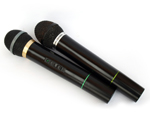The world of wireless microphones continues to evolve and become more complicated with every passing day. Just a brief re-cap of the last couple years: The FCC has passed a series of rules over the last few years to move the analog TV stations out of the 700MHz band and force them to broadcast all digital signals. The 700MHz band was then sold off at auction to private companies. This band of frequencies was one of the most popular for wireless microphones and the auction meant that this band could no longer be used for wireless mics. The latest rule from the FCC mandates that all secondary users of frequencies in this range must cease operation by June 10, 2010, regardless of whether there is specific interference.
So what’s next in this little saga? Where are the white space devices that are intended to operate in the rest of the usable wireless microphone range (approximately 500 MHz – 600 MHz, with some exceptions)? The FCC indicated they would set up a database for all authorized users so that white space devices wouldn’t interfere, although it sounds like this will only include broadcasters. Most churches and other users of wireless microphones might not be able to register. Late last year, the FCC sent out a request for proposals from companies that would administer the database, but proposals aren’t due until June 4, 2010 (click here for link). In theory, any white space device has to check the database and scan for signals from other transmitting devices once every minute. The device can’t operate on a frequency that is already occupied by either of these. Hopefully these will work better than the rest of our handheld wireless devices, which often leave much to be desired.
You don’t have to look too closely in the media to see where the FCC is going with things. Check out this article from TVNewsCheck. And this resource from the FCC. The FCC is intending to capture a fair bit of the remaining UHF spectrum for broadband access. If they’re lucky, broadcasters might get to keep some of the space for TV broadcasting. Which probably means that the “safe haven” of the lower UHF band would almost certainly become off-limits (or at least more restricted) for wireless microphones just like the 700 MHz band is now. Fortunately, the FCC is a government agency and moves slowly, so the sky is not likely to fall immediately. But things will definitely keep changing, and we can’t be too confident that wireless microphones are safe for the long term.
On a bright note, there has been legislation recently introduced that would provide for an actual engineer that understands this information to advise the FCC members. While this would certainly be a positive thing, the scary part is that they don’t already have it. The picture I’m seeing is that the FCC is a bunch of appointees and politicos who don’t really understand the technology and implications of their decisions. Which, if you look at how the process has been run so far and the decisions that have been made, it explains quite a bit!
Acoustics By Design is an independent acoustical engineering and audio-visual design firm. Our engineers work hard to keep up to speed on the issues, so we make sure we’re designing systems that meet the needs of this ever changing technology landscape.
